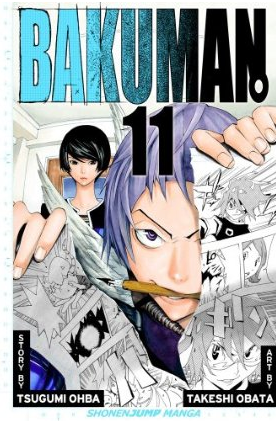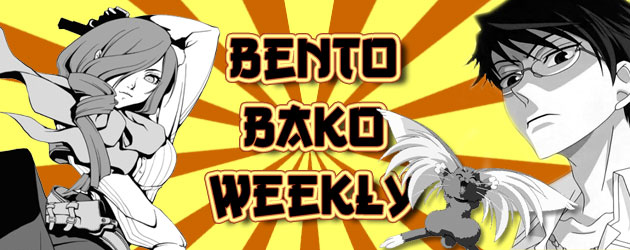 Bakuman volumes 11 and 12
Bakuman volumes 11 and 12
Publisher: Viz Media (Shonen Jump Line)
Story: Tsugumi Ohba
Art: Takeshi Obata
Bakuman volumes 11 and 12 are out now from Viz’s Shonen Jump line, continuing the dramedy manga, about making manga, from the team of Ohba and Obata, who also created the hit Death Note.
Volume 11 is a really great jumping on point if you’ve never read Bakuman before. The manga duo of Mashiro and Takagi create a brand new series, called PCP, but not without a lot of challenges and headaches along the way. The first is to get that title, the second to get the character design, and more importantly the character names, just right and set in stone. The manga premieres number one in rankings with its first chapter, even against their rival Eiji’s one-shot motorbike racing manga, but very soon as times passes it drops in the rankings against other titles like Crow and +Natural. To make things worse, a time table is put on this manga, and if PCP drops below 5th ranking by its 25th chapter, the manga will be dropped altogether from Jump! The rival mangaka begin to catch on to what is going on, and their dueling manga becomes intense, wanting each other to succeed let alone still have theirs out beat their rivals’. A death kiss seems delivered when Crow and +Natural do a cross-over for several stories, but Mashiro and Takagi have a trick up their sleeve, which is a 5-part story that delivers until their 24th chapter, a do-or-die move, being it could kill or secure their ranking in the top 5 and choose the fate of them being cancelled or not. The gamble pays off and they hit their mark, getting the chance to continue to work in Jump.
Volume 12 keeps the pace going as our duo secured staying in Jump, but on the horizon bigger hopes arise, namely PCP becoming an anime. This dream very quickly becomes shot down, because the editors at Jump apparently get enough parent complaints about PCP and its characters committing crimes, therefore it’s not the kind of manga that Jump turns into an anime. However, PCP does get a drama-CD and an offer for a light novel, but no anime option on the horizon has Mashiro’s wheels turning, and if he can just speed up his art and get fast enough, they could maybe even do a second story at the same time, which could become an anime. While all this is going on, their assistants start story boarding ideas for their own manga series proposals, and with a little help, Shiratori comes up with a great fantasy story about a boy and psychic dog, which gets offered to be a one-shot in Jump! Not only that, but Takagi will write the story since he was editing the story boards! This turns two things into the motion. The first is Mashiro’s crisis. He’s says he’s cool with Takagi writing the story, but Mashiro really wants them to do a second story so they can achieve creating an anime. Now Mashiro declares he will learn to draw faster, and even if he has to do a second story solo, to Takagi’s dismay, he will create something that becomes an anime. At the same time it turns out Shiratori’s family are a bunch of snobs, and they either want him to become a painter or work for his Dad’s company, not become something “lowly” like a manga artist. This causes Shiratori to move out with his dog and spend a few homeless days in the park as he looks for a new place. Our main duo become wise to what is going on and help him get a place, but the volume isn’t over until the final confrontation with Shiratori’s family.
 Bakuman still has a very unique combination of “behind the scenes” and shonen manga in one package. While some may not at first think of this as a traditional shonen formula, aside from a young man trying to achieve his goal or dreams, certainly with the way these manga artists behind the scenes challenge each other, and the way that votes define rankings for Jump-titles (both in the manga and real life), make this as much of a Shonen-competition manga as any other. Just with the fighting being fought out through drawing comics instead of fists, as they call each other up on the phone to exchange challenges and curse at one another behind the scenes. I think Ohba and Obata do a great job with the writing and art of this manga, as well as exposing the behind the scenes of the current manga world to readers (I guess credit is also due to Jump for letting them get away with it).
Bakuman still has a very unique combination of “behind the scenes” and shonen manga in one package. While some may not at first think of this as a traditional shonen formula, aside from a young man trying to achieve his goal or dreams, certainly with the way these manga artists behind the scenes challenge each other, and the way that votes define rankings for Jump-titles (both in the manga and real life), make this as much of a Shonen-competition manga as any other. Just with the fighting being fought out through drawing comics instead of fists, as they call each other up on the phone to exchange challenges and curse at one another behind the scenes. I think Ohba and Obata do a great job with the writing and art of this manga, as well as exposing the behind the scenes of the current manga world to readers (I guess credit is also due to Jump for letting them get away with it).
As a note, some readers may say there is a flaw in volume 12 given that PCP was not being produced as an anime because of parent complaints. After all, Jump produced Fist of the North Star, which became a long running anime and motion picture, and that was hugely violent! This is not a flaw at all in reality, and actually a sign of the times. Back in the 1980s, it’s true that Fist of the North Star was huge (as well as hugely violent), and although there were even parental complaints back then, it was already on TV, and when they started rolling in the money and ratings, well money talks. However, Fist of the North Star would not get produced on today’s prime time anime TV. Between parents in Japan and the industry realizing things such as foreign markets, shows like that don’t get produced, except as an occasional late-night anime, 30 years later (and the ones that do aren’t really based on Jump titles).
Bakuman volumes 11 and 12 are great jumping on points, as they are starting a what feels/reads as a new arc here, and everything is laid out very friendly for new readers. The volumes are available in both print and digital from Viz.
Drew McCabe
drew@comicattack.net
Review copies provided by Viz Media.


